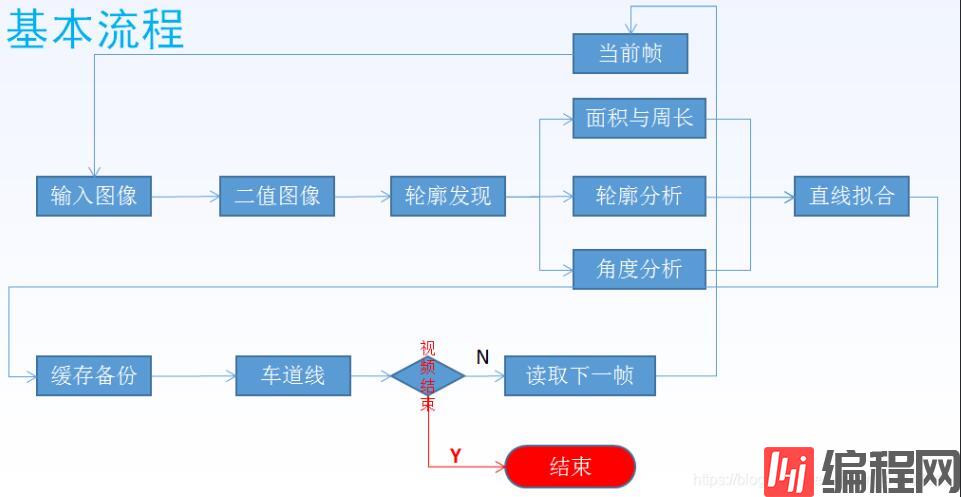使用opencv怎么实现一个车道线检测功能
这篇文章给大家介绍使用opencv怎么实现一个车道线检测功能,内容非常详细,感兴趣的小伙伴们可以参考借鉴,希望对大家能有所帮助。
原理:
算法基本思想说明:
传统的车道线检测,多数是基于霍夫直线检测,其实这个里面有个很大的误区,霍夫直线拟合容易受到各种噪声干扰,直接运用有时候效果不好,更多的时候通过霍夫直线检测进行初步的筛选,然后再有针对性的进行直线拟合,根据拟合的直线四个点坐标,绘制出车道线,这种方式可以有效避免霍夫直线拟合不良后果,是一种更加稳定的车道线检测方法,在实际项目中,可以选择两种方法并行,在计算出结果后进行叠加或者对比提取,今天分享的案例主要是绕开了霍夫直线检测,通过对二值图像进行轮廓分析与几何分析,提取到相关的车道线信息、然后进行特定区域的像素扫描,拟合生成直线方程,确定四个点绘制出车道线,对连续的视频来说,如果某一帧无法正常检测,就可以通过缓存来替代绘制,从而实现在视频车道线检测中实时可靠。
原理图:

代码:
#include <opencv2/opencv.hpp>#include <iostream>#include <cmath>using namespace cv;using namespace std;Point left_line[2];Point right_line[2];void process(Mat &frame, Point *left_line, Point *right_line);Mat fitLines(Mat &image, Point *left_line, Point *right_line);int main(int argc, char** argv) { //读取视频 VideoCapture capture("E:/opencv/road_line.mp4"); int height = capture.get(CAP_PROP_FRAME_HEIGHT); int width = capture.get(CAP_PROP_FRAME_WIDTH); int count = capture.get(CAP_PROP_FRAME_COUNT); int fps = capture.get(CAP_PROP_FPS); //初始化 left_line[0] = Point(0,0); left_line[1] = Point(0, 0); right_line[0] = Point(0, 0); right_line[1] = Point(0, 0); cout << height<<" "<< width<< " " <<count<< " " <<fps << endl; //循环读取视频 Mat frame; while (true) { int ret = capture.read(frame); if (!ret) { break; } imshow("input", frame); process(frame, left_line, right_line); char c = waitKey(5); if (c == 27) { break; } }}void process(Mat &frame, Point *left_line, Point *right_line ){ Mat gray,binary; cvtColor(frame, gray, COLOR_BGR2GRAY); //threshold(gray, binary, ); //边缘检测 Canny(gray, binary, 150, 300); //imshow("Canny", binary); for (size_t i = 0; i < (gray.rows/2+40); i++) { for (size_t j = 0; j < gray.cols; j++) { binary.at<uchar>(i, j) = 0; } } imshow("binary", binary); //寻找轮廓 vector<vector<Point>> contours; findContours(binary, contours, RETR_EXTERNAL, CHAIN_APPROX_SIMPLE); Mat out_image = Mat::zeros(gray.size(), gray.type()); for (int i = 0; i < contours.size(); i++) { //计算面积与周长 double length = arcLength(contours[i], true); double area = contourArea(contours[i]); //cout << "周长 length:" << length << endl; //cout << "面积 area:" << area << endl; //外部矩形边界 Rect rect = boundingRect(contours[i]); int h = gray.rows - 50; //轮廓分析: if (length < 5.0 || area < 10.0) { continue; } if (rect.y > h) { continue; } //最小包围矩形 RotatedRect rrt = minAreaRect(contours[i]); //cout << "最小包围矩形 angle:" << rrt.angle << endl; double angle = abs(rrt.angle); //angle < 50.0 || angle>89.0 if (angle < 20.0 || angle>84.0) { continue; } if (contours[i].size() > 5) { //用椭圆拟合 RotatedRect errt = fitEllipse(contours[i]); //cout << "用椭圆拟合err.angle:" << errt.angle << endl; if ((errt.angle<5.0) || (errt.angle>160.0)) { if (80.0 < errt.angle && errt.angle < 100.0) { continue; } } } //cout << "开始绘制:" << endl; drawContours(out_image, contours, i, Scalar(255), 2, 8); imshow("out_image", out_image); } Mat result = fitLines(out_image, left_line, right_line); imshow("result", result); Mat dst; addWeighted(frame, 0.8, result, 0.5,0, dst); imshow("lane-lines", dst);}//直线拟合Mat fitLines(Mat &image, Point *left_line, Point *right_line) { int height = image.rows; int width = image.cols; Mat out = Mat::zeros(image.size(), CV_8UC3); int cx = width / 2; int cy = height / 2; vector<Point> left_pts; vector<Point> right_pts; Vec4f left; for (int i = 100; i < (cx-10); i++) { for (int j = cy; j < height; j++) { int pv = image.at<uchar>(j, i); if (pv == 255) { left_pts.push_back(Point(i, j)); } } } for (int i = cx; i < (width-20); i++) { for (int j = cy; j < height; j++) { int pv = image.at<uchar>(j, i); if (pv == 255) { right_pts.push_back(Point(i, j)); } } } if (left_pts.size() > 2) { fitLine(left_pts, left, DIST_L1, 0, 0.01, 0.01); double k1 = left[1] / left[0]; double step = left[3] - k1 * left[2]; int x1 = int((height - step) / k1); int y2 = int((cx - 25)*k1 + step); Point left_spot_1 = Point(x1, height); Point left_spot_end = Point((cx - 25), y2); line(out, left_spot_1, left_spot_end, Scalar(0, 0, 255), 8, 8, 0); left_line[0] = left_spot_1; left_line[1] = left_spot_end; } else { line(out, left_line[0], left_line[1], Scalar(0, 0, 255), 8, 8, 0); } if (right_pts.size()>2) { Point spot_1 = right_pts[0]; Point spot_end = right_pts[right_pts.size()-1]; int x1 = spot_1.x; int y1 = spot_1.y; int x2 = spot_end.x; int y2 = spot_end.y; line(out, spot_1, spot_end, Scalar(0, 0, 255), 8, 8, 0); right_line[0] = spot_1; right_line[1] = spot_end; } else { line(out, right_line[0], right_line[1], Scalar(0, 0, 255), 8, 8, 0); } return out;}关于使用opencv怎么实现一个车道线检测功能就分享到这里了,希望以上内容可以对大家有一定的帮助,可以学到更多知识。如果觉得文章不错,可以把它分享出去让更多的人看到。
免责声明:
① 本站未注明“稿件来源”的信息均来自网络整理。其文字、图片和音视频稿件的所属权归原作者所有。本站收集整理出于非商业性的教育和科研之目的,并不意味着本站赞同其观点或证实其内容的真实性。仅作为临时的测试数据,供内部测试之用。本站并未授权任何人以任何方式主动获取本站任何信息。
② 本站未注明“稿件来源”的临时测试数据将在测试完成后最终做删除处理。有问题或投稿请发送至: 邮箱/279061341@qq.com QQ/279061341














